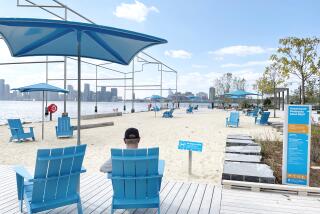Traveling Yacht Owners Giving Pricey Harbor Basins the Slip : Real estate: None have sold at glamourous North Cove port. ‘Dockominium’ values range up to $2.5 million.
NEW YORK — The avaricious ‘80s must be over. Even the most prestigious waterfront property in Manhattan is going begging.
We are not just talking river view, we are talking in the Hudson River.
At the foot of the World Financial Center on Manhattan’s southern tip sits the glamorous, granite-trimmed North Cove Yacht Harbor, designed to accommodate the 80- to 150-foot “mega-yachts” of traveling tycoons, corporate executives and Middle Eastern princes.
When North Cove opened last summer on publicly owned property, its developers at Watermark Associates hailed it as the first European-style mega-yacht harbor in the continental United States, a necessity for which yachting aficionados long banished to Mediterranean and Caribbean outposts had been clamoring.
Money is no object to such moguls, the developers insisted. Accordingly, prices for a 50-year lease on a “dockominium” range from $1.2 million to $2.5 million, petty cash for people who spend as much as $10 million to build a boat and more than $1 million annually to maintain it.
But on an average day this summer, at the height of the yachting season, only eight of the berths are occupied. Eighteen others sit empty, their fresh-water hookups, multiple telephone wires, 200 amperes of electricity and cable television lines just waiting to be connected to some sleek schooner.
Not a single slip has been sold, although several corporate yacht owners have expressed interest, said Peter Kiernan, Watermark’s chief executive and the savvy city lawyer who escorted the project past bureaucrats and opponents.
The site is owned by the public Battery Park City Authority, which considered using the area for a ferry basin or floating swimming pool before giving Watermark Associates a 50-year lease. “The political riddle was how do you put rich people’s playthings on poor man’s land,” Kiernan said, “and the answer is to make it accessible to the public. There are no fences down there. People can walk up and practically touch the boats if their arms are long enough.”
On a recent morning, several couples and a gray-suited executive on a coffee break strolled along the quays peering at the smoked-glass windows of boats such as Elegante, Dragon Lady IV and T-Bone.
“At lunchtime, you might have 1,000 people staring at you,” said Capt. William Kijovsky of the Elegante’. “It’s a little like living in a fishbowl.”
Kijovsky showed a visitor the yacht’s parquet floors, polished teak bar, Waterford crystal service for 12 and plush staterooms with hand-painted silk murals. Although a thief sneaked aboard and stole a wineglass, security generally has been no problem at North Cove, Kijovsky said, pointing to a green-helmeted guard cruising past on a motorbike.
In the roomy basin, five boats bobbed like lonely rubber ducks. Stars & Stripes, a winner in the America’s Cup yacht racing series, swayed in one corner, its mast as high as the fifth floor of the Financial Center.
A half-full harbor is hardly what North Cove founders George Nicholson and Emilio Azcarraga, a Mexican media mogul, expected when, at the height of the boom-time in the ‘80s, they conceived of a high-priced yacht harbor in New York.
Nicholson, who is heir to a British yachting dynasty and is credited with coining the term “mega-yacht,” launched the idea of building a European-style harbor when he could find no suitable spot in New York City to dock Azcarraga’s 147-foot Azteca after a transatlantic trek.
His concept was that, with more and more wealthy entrepreneurs doing business from their yachts--a development made possible by the advent of secure satellite communications--a berth at the foot of the World Financial Center would be irresistible and convenient.
“These yachts are in some cases the ultimate statement of having arrived,” said Neil Osborne, Watermark’s vice president, a Scotsman in natty blue blazer and matching handkerchief. “They already have two or three houses, but those are predictable things.”
North Cove’s founders expected that any resistance by yachtsmen to anchoring their museum pieces on the fringes of gritty, downtown Manhattan would be overcome by the city’s unique amenities. “You can get someone a pastrami sandwich at 2 o’clock in the morning in New York,” Osborne said. “You can’t do that in Antibes or anywhere in the Mediterranean.”
The allure of nocturnal pastrami seems to be less than was expected. Kiernan attributed lack of sales to the fact that paperwork giving approval for the slip sales was not finished until June. He added that Watermark has not undertaken aggressive marketing.
However, the elite brotherhood of mega-yachters, believed to number about 1,200 oceanwide, has been aware of New York’s new dock digs for years. They read about it in yachting journals, saw it in a videotape distributed by Watermark and a select 100 received a promotional picture book.
Could it be that the price is scaring away even the mega-rich, that in the roller-coaster economy, even the wildly wealthy are wary?
“There’s a saying, ‘Where the big boats go, the little boats follow,’ and that holds true even within the mega-yacht community,” said James Robie Gilbert, editor of Florida-based Showboats International who returned recently from Monaco, where he heard much discussion about North Cove.
“A lot of them are taking a wait-and-see attitude,” he said. “If (the late publisher) Malcolm Forbes had bought a slip, or if (real-estate developer) Larry Silverstein had bought one or people who are high-profile yachtsmen in New York, there would have been a sort of domino effect.”
More to Read
Inside the business of entertainment
The Wide Shot brings you news, analysis and insights on everything from streaming wars to production — and what it all means for the future.
You may occasionally receive promotional content from the Los Angeles Times.










